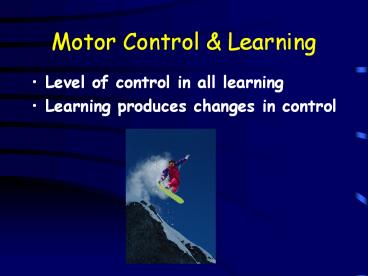Motor Control - PowerPoint PPT Presentation
Title:
Motor Control
Description:
... Human Action. Flexibility. Ability to recruit different muscles and joints to achieve same action ... Characteristics of Human Action. Consistency of Action ... – PowerPoint PPT presentation
Number of Views:52
Avg rating:3.0/5.0
Title: Motor Control
1
Motor Control Learning
- Level of control in all learning
- Learning produces changes in control
2
Learner
Task
Environment
3
Motor Skill Defined
- Requires body /or limb movement
- Voluntary
- Goal directed
- Learned
4
Characteristics of Human Action
- Flexibility
- Ability to recruit different muscles and joints
to achieve same action - Uniqueness
- No two movements are ever performed in exactly
the same way
5
Characteristics of Human Action
- Consistency of Action
- Temporal and spatial aspects of a movement remain
relatively stable from one performance to the
next - Modifiability of Action
- Ability to alter a movement pattern, even as it
is being executed
6
Classification of Motor Skills
7
One-Dimensional Classifications
- SIZE OF MUSCULATURE INVOLVED
- Gross motor Fine motor
8
One-Dimensional Classifications
- DISTINCTIVENESS OF MOVEMENT
- Discrete Continuous
9
One-Dimensional Classifications
- STABILITY OF ENVIRONMENT
- Closed Open
10
Environmental Dimension
- Demands placed on performer by the environment
(Performance Space) - Move Where? Spatial
- Move When? Temporal
- Move Where When? Spatial Temporal
Constraints
11
Closed Skill
- Characteristics
- Self-paced
- Fixed Environment
- Spatial Control
- Highly Predictable
12
Open Skill
- Characteristics
- Externally-paced
- Changing Environment
- Spatial Temporal control
- Skill Level of Performer
13
Two-Dimensional Classification
- Stationary Motion
- No variability Variability
Regulatory conditions
CONTEXT
14
Batting Tee Same height
Pitch Machine Same speed/place
Live Pitch
Batting Tee Various heights
Stationary No variability
Stationary Variability
In Motion No Variability
In Motion Variability
15
Two-Dimensional Classification
FUNCTION
- Body Stability Object
- Body Transport No Object
16
Two-Dimensional Classification
Stationary Motion No
variability Variability
Body Stability Object Body
Transport No Object
CONTEXT
FUNCTION
17
Why is two-dimensional classification system
useful?
Applying the system































